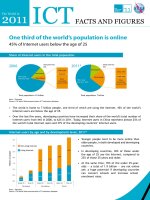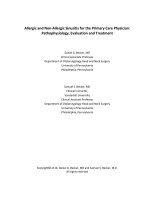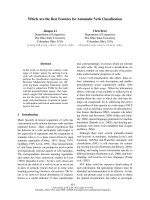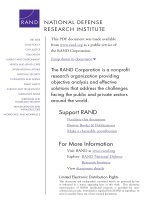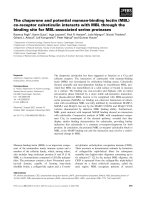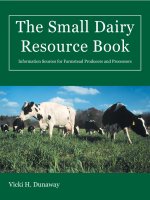PROFESSOR TRIM’S QUICK START THE WEIGHT-LOSS PROGRAM for new mothers and mothers-to-be pdf
Bạn đang xem bản rút gọn của tài liệu. Xem và tải ngay bản đầy đủ của tài liệu tại đây (262.91 KB, 88 trang )
PROFESSOR TRIM’S
QUICK START
New Mothers 15/5/03 11:24 AM Page i
PROFESSOR TRIM’S PROFESSORS
Professor John Blundell PhD, C Psychol, MBPS
Professor of Bio-Psychology, Leeds University, UK and
Board Member of the International Association for the
Study of Obesity (IASSO)
Professor Wendy Brown BSc (Hons), MSc, Dip Phys Ed, PhD
Professor of Physical Activity and Health, University of Queensland
Professor Ian Caterson MBBS, BSc (Med), PhD, FRACP
Boden Professor of Human Nutrition, Sydney University and
Vice President, IASSO
Professor Terry Dwyer MBBS, MPH, MD, FAFPHM
Director Menzies School of Health Sciences Hobart, and
University of Tasmania
Professor Garry Egger MPH, PhD, MAPS
Director, Centre for Health Promotion and Research Sydney
Adjunct Professor of Health Sciences, Deakin University
Professor James Hill PhD
Director, Center for Human Nutrition, University of Colorado
Health Sciences Center and Co-Founder,
National Weight Control Registry
Professor Kerin O’Dea BSc, PhD
Director of Menzies School of Health Research, Darwin
Professor Stephan Rossner MD, PhD
Director, Obesity Research Program, Luddinge Hospital,
Stockholm, Sweden and Past President of IASSO
Professor Boyd Swinburn MD, MBChB, FRACP
Professor of Population Health and Nutrition, Deakin University
Professor Klaas Westerterp PhD
Professor of Human Energetics, Head of Department of Human
Biology, Maastricht University, The Netherlands
New Mothers 15/5/03 11:24 AM Page ii
PROFESSOR TRIM’S
QUICK START
THE WEIGHT-LOSS PROGRAM
for new mothers and
mothers-to-be
Dr Katherine Samaris
MB, BS, PhD, FRACP
Dr Garry Egger
MPH, PhD, MAPS
New Mothers 15/5/03 11:24 AM Page iii
First published in 2003
Copyright © Katherine Samaris 2003
Copyright © Garry Egger 2003
All rights reserved. No part of this book may be reproduced or
transmitted in any form or by any means, electronic or mechanical,
including photocopying, recording or by any information storage
and retrieval system, without prior permission in writing from the
publisher. The Australian Copyright Act 1968 (the Act) allows a
maximum of one chapter or 10% of this book, whichever is the
greater, to be photocopied by any educational institution for its
educational purposes provided that the educational institution (or
body that administers it) has given a remuneration notice to
Copyright Agency Limited (CAL) under the Act.
Allen & Unwin
83 Alexander Street
Crows Nest NSW 2065
Australia
Phone: (61 2) 8425 0100
Fax: (61 2) 9906 2218
Email:
Web: www.allenandunwin.com
National Library of Australia
Cataloguing-in-Publication entry:
Samaris, Katherine.
Egger, Garry.
Quick start weight-loss program for new mothers and mothers-to-be.
ISBN 1 74114 117 6.
1. Weight-loss. 2. Women–Nutrition. 3. Physical fitness for women.
I. Title. (Series: Professor Trim’s medically supervised weight-loss
programs).
613.7045
Set in 11/12.5 pt Adobe Garamond by Midland Typesetters,
Maryborough, Victoria
Printed by Griffin Press, South Australia
10987654321
New Mothers 15/5/03 11:24 AM Page iv
CONTENTS
Introduction
How to use Professor Trim’s Quick Start Weight-Loss
Program for New Mothers and Mothers-to-be vii
Part 1 Background
1 Obesity and the modern environment 3
2 General nutrition for weight management 9
3 More movement makes mightier mums 20
4 Stressing up for (more) dinner 27
Part 2 Motherhood
Pre-pregnancy
5 When weight gets in the way 35
Pregnancy
6 A natural process 45
7 Special nutritional requirements in pregnancy 54
8 Special considerations in pregnancy 60
Post-partum
9 Weight management after childbirth 65
10 Myths associated with pregnancy and
body weight 71
Appendix
Purchasing Professor Trim’s Medically Supervised
Weight-Loss Programs 77
New Mothers 15/5/03 11:24 AM Page v
ABOUT THE AUTHORS
Garry Egger is Director of the Centre for Health
Promotion and Research in Sydney and Adjunct
Professor of Health Sciences at Deakin University.
He has been involved in health promotion for almost
30 years and is the author of more than 25 books.
Katherine Samaris is a Consultant Endocrinologist at
St Vincent’s Clinic and St Vincent’s General Hospital,
Sydney. She is actively involved in diabetes and obesity
research at the Gavin Institute of Medical Research.
New Mothers 15/5/03 11:24 AM Page vi
INTRODUCTION: How to
use Professor Trim’s Quick
Start Weight-loss Program
for New Mothers and
Mothers-to-be
The Professor Trim’s (PT) Quick Start program in this
book is an introduction to effective weight loss, and a life-
time of weight management, for new mothers and mothers-
to-be. It differs from other pregnancy advice in that it’s
aimed mainly at mothers—although never neglecting the
health of the baby. Most information for new mums,
you’ll find, is focused on the health of the child. And
while no one would deny the importance of this, the
ongoing health of the mother often seems to be forgotten.
Pregnancy and childbirth are critical periods for weight
gain in women and the weight that’s gained at these times
is often difficult to lose over the long term. Since excess
body weight can be a health risk, it’s crucial that all the
best available scientific information be put into helping
women at these stages in their life. This doesn’t mean
ignoring the needs of the baby. Indeed, as we will see,
maintaining ideal weight and good health in the mother
is likely to improve childbirth outcomes. The Professor
Trim program is designed to do just that.
vii
New Mothers 15/5/03 11:24 AM Page vii
PROFESSOR TRIM’S—THE HISTORY
Professor Trim’s evolved from the ‘GutBuster’ program,
which started as a men’s ‘waist-loss’ program in 1991.
GutBusters became the biggest, and most successful,
men’s weight-loss program in the world. It had an inter-
nationally acclaimed scientific advisory board and was
consistently rated by consumer groups as among the best
weight-loss programs available.
Initially designed for men, GutBusters soon devel-
oped a program for women. Hence the Professor Trim’s
range of programs—for men and women, and these
Quick Start versions.
Several thousand Australian doctors (see www
.
professortrim.com) have had special training in weight
control as part of a Postgraduate Medical Certificate in
Weight Control and Obesity Management from Sydney
University. These doctors, and the Professor Trim’s
Medically Supervised Weight-Loss Program, can help new
mums through a shared-care system that provides the
best information available on weight loss and weight
management.
MORE PROFESSOR TRIM’S ADVICE
More intensive individual programs will continue the
quick start to weight loss you’ll get from this program.
Information about the full Professor Trim’s programs are
contained in the back of this bookset. You can also
purchase these directly from your PT doctor and work
with him or her through the full twelve months of the
program, or longer.
The way to get the greatest benefit from this Quick
Start new mum’s program is first to read the book. You
can then access regular updates on current research and
NEW MOTHERS AND MOTHERS-TO-BE
viii
New Mothers 15/5/03 11:24 AM Page viii
information from the Professor Trim Internet site at
www
.professortrim.com. At the end of each chapter in
this booklet you will find an easy-to-follow summary of
its contents, contained in a Professor Trim’s Prescription
Pad. Use these summaries as your checklist for putting
the program into action.
STRUCTURE OF THE PROGRAM
The information contained in this book is divided into
two parts. The first part, ‘Background’, provides a
summary of general weight loss information—nutrition,
physical activity and stress management in particular—
to set the stage for modifications to this with mother-
hood. The second part, ‘Motherhood’, discusses the specific
requirements for weight management before, during and
after pregnancy. The reason that both the ‘before’ and
‘during’ pregnancy periods are considered so important
here is that taking preventable action in these stages can
make long-term weight control after childbirth much
more manageable.
Best results are likely to be achieved by fully preparing
for weight management in the pre-pregnancy, ‘before’
phase. Since about half of all pregnancies are unplanned,
however, we appreciate this is not always possible. Hence
actions taken during pregnancy might represent the first
attempt to deal with a weight problem. Where action is
left until after delivery, the problem becomes more diffi-
cult, but not impossible to solve. Women reading this
who have already put on weight after giving birth should
consider all of the advice as part of their preparation
for any future pregnancies. For those who have finished
their family, the complete Professor Trim’s ‘Becoming
Slimmer’ program for women is another alternative.
INTRODUCTION
ix
New Mothers 15/5/03 11:24 AM Page ix
NEW MOTHERS AND MOTHERS-TO-BE
x
Professor Trim’s Prescription Pad
• Read this booklet first.
• Try to put the recommendations at the end of
each chapter into action.
• Check in at the Professor Trim Website
(www
.professortrim.com).
• Check in with your Professor Trim doctor for
ongoing help.
• For more specific programs, and a ‘personal
weight coach’, see the Appendix on page 77.
New Mothers 15/5/03 11:24 AM Page x
Part 1
Background
New Mothers 15/5/03 11:24 AM Page 1
New Mothers 15/5/03 11:24 AM Page 2
Chapter 1
OBESITY AND THE
MODERN ENVIRONMENT
OBESITY—THE MODERN EPIDEMIC
Through thousands of years of evolution, humans were
kept lean by the effort required either to eat or avoid being
eaten. The ultimate goal was comfort—food on the table
at the end of the day, without having to toil too hard to
get it. By the twenty-first century this goal has been largely
achieved. But what nature gives on the roundabouts, it
takes on the swings. Obesity and overweight are the price
we pay for technological advancement and modernisation.
At the turn of the millennium, more than two in
every three Australian men and one in every two women
were classified as overweight. And although we don’t have
comparative figures for historically earlier times, it’s
certain that the numbers of overweight would have been
minute, compared with today.
Women fare particularly badly in this new world
because, biologically, they have been designed to get fat
more easily, and to store fat more efficiently, than men.
This is because the survival of the evolving human race
meant it was necessary for a woman to both survive the
nine months of pregnancy and to nourish the baby after-
wards. To do this their bodies had to lay down extra
energy reserves (i.e., fat) as a form of insurance against
famine, a process which became very effective. And while
the trials of day-to-day life in past ages ensured that the
3
New Mothers 15/5/03 11:24 AM Page 3
effects of weight gain were readily counteracted after
childbirth, the easier way of life in our modern environ-
ment makes this weight loss no longer automatic.
PREGNANCY AND BODY WEIGHT
Pregnancy is a period of necessary weight gain in a woman,
resulting not only from the weight of the growing foetus,
but also from the extra reserves required to feed that
foetus. Natural increases in hunger will normally drive the
increase in body weight required for an ideal pregnancy.
However, in the modern environment this ‘biological
hunger’ is often confused with ‘learned appetite’ and
hence the desire to eat may not necessarily be biologically
driven. On top of this, there are tendencies in modern
societies to condone ‘eating for two’ by a pregnant
woman, even if this amounts to over-eating, and to be
over-protective of a woman being too active during her
pregnancy. As a result, pregnancy and motherhood have
become almost synonymous with permanent weight
gain. Yet a glance back through history tells us that this
need not be inevitable. Women in hunter-gatherer and
other subsistence existences rarely, if ever, gained perma-
nent weight as a result of childbirth. Hence the problem
can be seen to be associated with lifestyle, in particular,
the nature of modern technological societies.
PREGNANCY AND THE HEALTH OF
THE MOTHER
Traditionally, recommendations for weight gain during
pregnancy have been based on the health of the child.
In the modern environment, inadequate weight gain to
ensure a healthy baby is rarely the problem (except, of
NEW MOTHERS AND MOTHERS-TO-BE
4
New Mothers 15/5/03 11:24 AM Page 4
course, in the case of special circumstances or pre-term
delivery). The mother’s health, and the difficulty of
regaining a healthy body weight after childbirth, now
need to be taken into consideration in making recom-
mendations for pregnancy weight gain. As post-partum
weight retention is partly dependent on the amount of
weight gained in pregnancy, it would seem illogical to
suggest a greater gain in pregnancy than is necessary.
The good news is that this means permanent weight
gain doesn’t have to occur after childbirth. If lifestyle
changes are the key to weight gain in women in modern
technological societies after they give birth, the answer to
preventing the problem lies in becoming aware of these
changes and making the necessary adjustments to reduce
their impact. This doesn’t mean going back to hauling
water from the nearest freshwater spring or washing
clothes by hand. But it does mean considering a long-
term plan for weight management.
The table below shows the factors that appear to be
most associated with weight gain in new mothers and
mothers-to-be.
Factors identified as tending to increase weight gain in
motherhood
Pre-pregnancy weight Excess weight before pregnancy
increases the risk of greater weight retention after giving birth.
Gestational weight gain The bigger the gain during preg-
nancy, the greater the difficulty of shedding the excess weight.
Number of pregnancies The difficulty in returning to ‘normal’
weight appears to increase with more births.
Lower educational level Less educated women have more
trouble losing post-pregnancy weight (suggesting that weight
maintenance can be learned).
OBESITY AND THE MODERN ENVIRONMENT
5
New Mothers 15/5/03 11:24 AM Page 5
Later return to work or activity An earlier return to work or high
activity levels can decrease the risk of weight retention.
Not breastfeeding Although not always a factor, breast-
feeding offers a ‘window of opportunity’ for long-term weight
maintenance in the mother, as well as a reduced risk of later
excess weight gain in the child.
Extreme dieting Trying to diet excessively can lead to ‘break-
outs’, or bingeing, when things go wrong, which result in even
greater weight gain.
Overeating, or ‘eating for two’ For many women, pregnancy
is an excuse to eat whatever they like to satisfy their cravings. And
while genuine cravings are an indication of need, these are often
confused in an environment of unlimited foods.
Post-partum depression This can lead to ‘comfort eating’ and
reduced activity, both of which increase the prospects of weight
gain
BEHAVIOUR CHANGE FOR WEIGHT LOSS
Because weight control programs are a dime a dozen, it
should be apparent that most don’t work. If they did,
why would there be so many? It would also seem logical
that one of the best ways to find out what does work is
to ask those who have successfully lost a lot of weight and
managed to keep it off for a long period.
Researchers in the United States have done this.
Dr James Hill from Colorado State University and his
colleagues have established a National Weight Control
Registry (NWCR) of a large number of people who have
lost a minimum of 14 kilograms and kept this off for
at least five years. These people have been subjected to a
range of different forms of research, which has shown
consistently similar conclusions about the best tech-
niques for long-term loss. Five main factors stand out:
NEW MOTHERS AND MOTHERS-TO-BE
6
New Mothers 15/5/03 11:24 AM Page 6
1. A lifestyle built around a high level of physical
activity This doesn’t mean a regular commitment
to an exercise regime (although this can help).
Accumulated movement, or physical activity built
into the lifestyle (adding up to at least 60–80
minutes a day for women), has the best effect.
2. A lifetime pattern of low-fat eating This doesn’t
imply a ‘diet’ as such, but an ongoing reduction of
foods that are high in fat and energy (calories).
3. Established techniques for managing stress Stress
can be an issue in causing compensatory ‘comfort
eating’. Ability to deal with day-to-day stresses is
associated with better long-term weight manage-
ment.
4. Self-monitoring This includes measuring such
things as the number of steps taken daily (using a
pedometer), the amount of fat in the daily food
intake, the number of servings of fruits and vege-
tables eaten each day, etc. Self-monitoring is
known to be one of the most effective methods
available for making a range of behaviour changes.
5. Eating breakfast This is the most important meal
of the day. Eating breakfast helps reduce food in-
take, and hence total energy, over the rest of the day.
Other factors that seem to be important, particularly for
women either contemplating pregnancy or about to
become mothers, are:
• Unlearning old habits These often die hard, but
habits such as eating for comfort, or being passive
instead of active, are often the cause of significant
weight problems. The good news is that if they
can be learned in the first place, they can also be
unlearned.
OBESITY AND THE MODERN ENVIRONMENT
7
New Mothers 15/5/03 11:24 AM Page 7
• Learning new habits Replacing negative ways
of thinking with more rational, positive ways of
thinking, is often as good as, or better than, any
diet program for weight loss.
NEW MOTHERS AND MOTHERS-TO-BE
8
Professor Trim’s Prescription Pad
• Weight gain is normal and healthy in preg-
nancy—but it can be too much in the modern
environment, as well as too little.
• A number of factors are predictive of post-
partum weight retention.
• Behaviour change—mostly reduced physical
activity—is the main cause of weight gain after
childbirth.
• Long-term weight loss maintenance is best
achieved through a low-fat, reduced-energy
eating plan, regular exercise, self-monitoring
and establishing ways of dealing with stress.
New Mothers 15/5/03 11:24 AM Page 8
Chapter 2
GENERAL NUTRITION FOR
WEIGHT MANAGEMENT
In this chapter we’ll look at nutrition in general for weight
loss and weight management. Some aspects may need to be
modified when we consider individual phases of mother-
hood in later chapters, but the main principles as discussed
here will still be appropriate.
NUTRITION FOR WEIGHT LOSS
In general, nutrition for weight loss or weight manage-
ment is the same as nutrition for good health. In essence
this means:
• Not eating too much;
• Eating regularly;
• Eating a wide variety of foods to get balanced
nutrient intake;
• Not skipping meals, or attempting overly restric-
tive dieting; and
• Limiting rich, high energy dense foods.
These principles apply generally throughout the stages of
motherhood, from planning a pregnancy to after delivery.
FOOD VOLUME AND WEIGHT LOSS
Despite the hype about different types of diets for weight
loss, the issue basically boils down to the volume of food
9
New Mothers 15/5/03 11:24 AM Page 9
consumed in terms of total energy (calories or kilojoules),
which can be expressed as:
Volume = Energy density (kcals/g)
××
Portion size (g)
There are many different ways in which volume can be
decreased, some of which are associated with the type or
amount of foods eaten, and others with the management
of hunger.
New mothers and mothers-to-be do need to eat more
than most other women. But for many women in
modern Australia, the problem comes with eating not
just enough more, but eating too much more. It may
be quite unnecessary to drastically increase food intake
during pregnancy—particularly for those who are already
overweight. More important is a varied diet and an
adequate volume of food for the long-term benefits of
both mother and child. Here we consider the main
factors accepted scientifically as influencing food volume
and quality.
REDUCING DIETARY FAT
There’s been a lot of controversy recently about whether
fat or carbohydrate is the most important nutrient in
weight control. The answer should be clear; it’s total
energy (calories or kilojoules) that is important, irrespec-
tive of where these come from. However . . . because
there are 38 kJ per gram in fats and oils (remember oil
is just a liquid form of fat) and only 17 kJ per gram
in carbohydrate and protein, it’s much easier to take in
more calories through fat.
The long and the short of it is, if you can reduce fats
in your diet (including those commonly regarded as
good fats, such as olive oil), even throughout pregnancy,
NEW MOTHERS AND MOTHERS-TO-BE
10
New Mothers 15/5/03 11:24 AM Page 10
you’ll go a long way to preventing a long-term weight
problem. Here are some simple ways to do this:
• Don’t use spreads like butter and margarine (or at
least spread them thinly) While some of the new
designer margarines may help your cholesterol,
they’re still up to 80 per cent fat (at 38 kJ) and just
add to your weight woes.
• Take the skin off chicken Birds store fat under
the skin. Animals store it more throughout the
muscles. Take the skin off before cooking, so
you’re not tempted to eat it afterwards.
• Don’t fry food in oils or butter Grill, bake, boil,
steam . . . whatever you like. Frying in oil results
in the 38 kJ being soaked up by the food and, ulti-
mately, stored on the body.
• Cut all visible fat off meat Fat on meat is easy to
see. It’s the white bits around the outside of the
T-bone or the grainy white bits throughout other
forms of red meat. Go for the low-fat meats,
which are generally whiter meats like veal, pork
and spring lamb. Otherwise trim all the fat off
before cooking—it’s too tempting after it’s been
cooked.
In case you’re wondering, it’s not necessary to
eat meat for a healthy pregnancy—unless you
want to. If you don’t like meat there’s no need to
force it down, as long as you are eating a wide
variety of foods, including some rich sources of
protein (like beans and lentils). The addition of a
multi-B vitamin and a folate supplement (from
a reputable supplier) is advisable.
• Avoid full-cream dairy products Cheese and full-
cream dairy products are large sources of fat. Milk
GENERAL NUTRITION FOR WEIGHT MANAGEMENT
11
New Mothers 15/5/03 11:24 AM Page 11
can be modified by going for the low-fat versions
(preferably one containing added calcium), but it’s
hard to get a true low-fat cheese. For this reason
cheese should be eaten in moderation.
WHAT IS LOW FAT?
To take the low-fat issue further than just the five tips
above, you’ll need to understand a bit about fat. There
are a couple of simple rules to work by. The Professor
Trim program stipulates that you should:
• Avoid foods with more than 10 per cent fat
How do you know if a food is more than 10 per
cent fat? Look for Professor Trim’s Ultimate Food
Energy Guide at any bookstore (a copy is supplied
with each full Professor Trim program). This will
tell you the number of grams of fat per 100 grams
in a stack of different foods. If a food has more
than 10g/100g (i.e., 10 per cent) fat, avoid it.
In fact, ban it from the house.
• Reduce your daily fat intake Again, from your
Ultimate Food Energy Guide you can check on
just how much fat you are eating in your diet.
Check the quantity of each food eaten and the
number of grams of fat it contains. Then try to
reduce your daily fat intake to around 30g a day
or less.
INCREASING DIETARY FIBRE
Fibre is mostly the ‘stringy’ part of foods, like the bits of
an orange that hold it together, or the bran on the outside
of a grain. There are different types of fibre, but for our
purpose here we’ll consider them all together and make
NEW MOTHERS AND MOTHERS-TO-BE
12
New Mothers 15/5/03 11:24 AM Page 12
the assumption that most high fibre, low energy dense
foods, such as fruits and vegetables, come from plants.
However fibre also exists in some manufactured foods,
such as bread, pasta and cereals.
Through increasing your fibre intake you’ll decrease
your fat intake, and thus have a double effect on your
excess body weight. A simple formula is to eat at least
three different fruits and four different vegetables a day,
and to increase your intake of pasta, breads (without
spreads) and cereals.
INCREASING THE PROPORTION
OF PROTEIN
Protein is muscle food. It comes mainly from the muscles
of the animals we eat, but other good low-fat sources are
beans, legumes and some other vegetables. Protein is of
particular importance during pregnancy because of the
need to create new body tissue.
Because protein goes into muscle in our bodies, and
muscle is active, it helps to increase metabolic rate—
provided this is combined with exercise (see Chapter 3).
Protein is also generally not turned to fat, because any
excess is lost as heat or passed out through the urine. It’s
important that the proportion of protein in your diet is
increased, not necessarily the total amount. This doesn’t
mean eating more food, as protein is a significant source
of food energy. It’s also important to make sure an
increase in protein comes from low-fat sources. The
table on the next page lists some good sources of such
protein.
Seafood is a good source of protein and also has bene-
fits for blood fats like cholesterol. Recent research has
shown that eating more fish can improve birth outcomes
GENERAL NUTRITION FOR WEIGHT MANAGEMENT
13
New Mothers 15/5/03 11:24 AM Page 13
in pregnant women and hence eating two or three
seafood meals (not fried or raw) per week should be a
standard recommendation for good health and weight
management.
DECREASING ENERGY DENSITY
‘Energy density’ is a relatively new term that refers to the
number of calories (kilojoules) per gram of food. The
reason it’s now used is that sometimes it’s not just fat
which adds to total calories, but high quantities of sugar
and/or fat. Energy density is calculated by dividing the
number of kilojoules in a food by the number of grams
of that food. Where this turns out to be less than 12.5kJ
per gram of food (3cals/g), it implies a high energy dense
food that should be avoided. Between 7.5 and 12.5kJ/g
is medium and below 7.5kJ/g is low energy density and
can be eaten in (almost) unlimited quantities (For a
summary of foods and their energy density see Professor
Trim’s Ultimate Food Energy Guide). The energy densities
of some well-known foods are given in this table.
NEW MOTHERS AND MOTHERS-TO-BE
14
Some low-fat sources of protein
Seafood Vegetables Meat
Fish (most kinds) Legumes Kangaroo
Prawns Lentils Crocodile
Lobster Lean beef
Crab Lean pork
Squid/octopus Lamb
Oysters (cooked, not raw) Chicken breast
Lean beef
New Mothers 15/5/03 11:24 AM Page 14
Some low-fat but high energy dense foods
Food Fat ED kcals/g
(g/100) (kJ/g)
Biscuit: savoury crispbread,
puffed and toasted 3.8 3.8 (16.1)
Biscuit: fruit, polyunsaturated, wholemeal 9.9 3.9 (15.9)
Bread: melba toast 4.9 3.8 (16.0)
Breadstick: hard 3.8 3.9 (16.3)
Breakfast biscuit, wholewheat, bran 7.6 3.5 (14.9)
Cereal (mixed grain, sugar more
than 35%, fortified) 4.2 3.8 (16.1)
Confectionery, carob coated, sugar 9.9 4.2 (17.5)
Cornflakes 0.5 3.7 (15.6)
Fudge, not chocolate, plain 4.2 3.8 (16.1)
Muesli, toasted 9.8 3.9 (16.2)
Mousse, low-fat, chocolate, artificially
sweetened 5.0 3.9 (16.3)
Popcorn, air-popped, no added fat 4.2 3.5 (14.8)
Pretzel, regular 7.2 3.8 (15.8)
Rice cake, natural, brown 3.4 3.7 (15.6)
Rice cake with corn and sesame 2.5 3.9 (15.0)
Turkish delight, chocolate-coated 9.8 4.0 (16.6)
REDUCING TOTAL ENERGY (CALS)/kJs
Whether we’re looking at fat, carbohydrate or protein, at
the end of the day it’s still the total amount of energy
(calories or kilojoules) that causes a weight problem. If
you’ve cut back on fatty foods and high energy dense
foods it’s almost impossible to eat too much food—
almost! But eating the right sorts of food for some people
can still be a problem, for while food quantity may need
to be increased during pregnancy, it does not need to be
GENERAL NUTRITION FOR WEIGHT MANAGEMENT
15
New Mothers 15/5/03 11:24 AM Page 15


